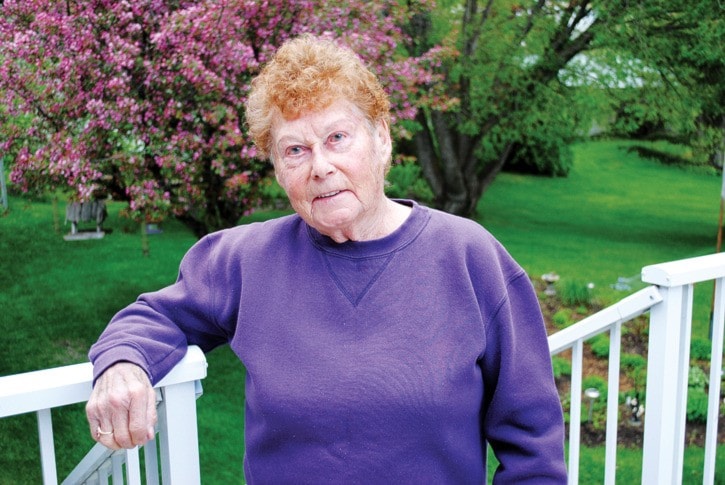Joan Huston has ranched, hunted, guided, timber cruised, managed recreation sites, spent summers officially watching for forest fires, scaled Christmas trees, and raised children, has grandchildren and great grandchildren, and a warm sense of humour.
A tall order for a woman who stands about five feet tall.
Born in Meldrum Creek, 86-year-old Huston has also called Riske Creek, Bear Creek and Soda Creek home.
Today she lives at McLeese Lake with her husband Vic Davis.
“It’s nice to look back now and think of all the things that went on,” Huston recalls.
Her life began in Meldrum Creek where her parents were working on her grandparents’ farm. Huston was one of two daughters born to Orville and Emogene (Stowell) McKay.
Huston’s mom, Emogene, was originally from Medford, Ore. Her dad, Orville, was from Redcliff, Alta.
Emogene’s parents, Gene and Sarah Stowell, wanted to ranch in the Cariboo because they’d heard there was more feed available so in 1912 they left Oregon and moved north, stopping first in Missoula, Montana and finally arriving in Riske Creek when Emogene was 12 years old.
Eventually the Sowells moved to Meldrum Creek onto 160 acres of land, where they homesteaded a place they called Tucky Home.
After the First World War, Orville, who had served in the army with the 72 Highlanders for four years, moved to the Cariboo.
“He came up to Soda Creek when they were putting the railroad through. He worked there for quite a while and then he drove a jitney on the road from Ashcroft to Quesnel,” Huston says.
While Orville was bartending in Soda Creek, he met Emogene who was then 18 and had moved to Soda Creek and was helping cook and serve food for the railway crews.
Huston figures there were about 2,000 people living in Soda Creek at the time.
Orville and Emogene were married in Quesnel in 1920. However, soon afterwards they moved out to Meldrum Creek to run the farm because Emogene’s father had returned to Meldford to work as a saw filer.
Growing up Huston and her sister Hazel helped with all the facets of the farm. In a self-published book titled Cariboo Hell Raiser, she penned in 2009, Huston recalls many stories from her younger years.
Stories about a pet bear, cutting down trees, or the time she and Hazel surprised themselves and won first place at a talent show in Williams Lake.
A strong young woman with spunk emerges continuously through the pages. Even the front cover photograph depicts her standing on a horse.
The books covers her life until 1949, and some of the remaining details she recently shared with the Tribune.
After she married, she and her husband Pat Huston bought 15 lots in Soda Creek.
“We owned pretty near the whole town and then we decided to move away and we sold it. Now it’s all divided into lots and there are houses all through there, but our old barn is there and our old house — the first big house going down into Soda Creek was ours.”
She raised two children — Ken Huston of Williams Lake and Patricia Rochefort of Little Duckworth Lake. Pat eventually passed away and she married Vern Davis.
She used to cut all the wood for recreation sites.
“I’d take a chain saw with me, and on the way to a lake stop and cut a bunch of pine and haul it out to all the campsites,” she recalls with a chuckle. “In a year or two they got millwrights when they were off work to cut a bunch of wood for me up at the forestry warehouse so then I’d just go there and load it up.”
As a fire tower employee she’d stay in a tower 50 feet above the ground alone, working 21 days on, and three days off.
She had a bed, a little fridge, and a stove and had to pack water up three sets of stairs.
“Quite a chore,” she recalls, adding it taught her to be careful about how much water she used.
While it was a long stretch up there, she had books, a TV and a big pot of coffee on because she had lots of visitors.
Her husband visited every Wednesday, and a steady stream of wildlife wandered by.
“It was really interesting,” she says, adding she took all of her fire training in Williams Lake.
Hot dry summers meant lots of fires and in those days there were other nearby fire towers to communicate with.
“I had a big fire finder up there and I would put the fire finder on the fire and give them the numbers and everything and then phone it in.”
The bird dog would arrive and if the pilot couldn’t spot the fire, Huston would guide the pilot over to the fire.
“In a lightning storm I would keep tabs of all the numbers and put them down. In a few days if it turned warm after a storm like that, then sometimes up to five or six days I would see a fire coming up right where the lightning had struck.”
 Photo submitted
Photo submitted
Joan Huston cuts firewood in the days when she looked after 14 recreation sites for the Ministry of Forests.
When it came to timber cruising – 30 C was the determining factor.
If it was below that the crew didn’t got out, Huston says.
Back around 1980, she remembers seeing bug-killed trees and says she and coworker reported seeing a lot of bugs and suggested they be logged.
“They said ‘oh no, there had to be a bit more kill than that before we can recommend that.’ It should have been looked at years ago. But then they just took a hold.”
